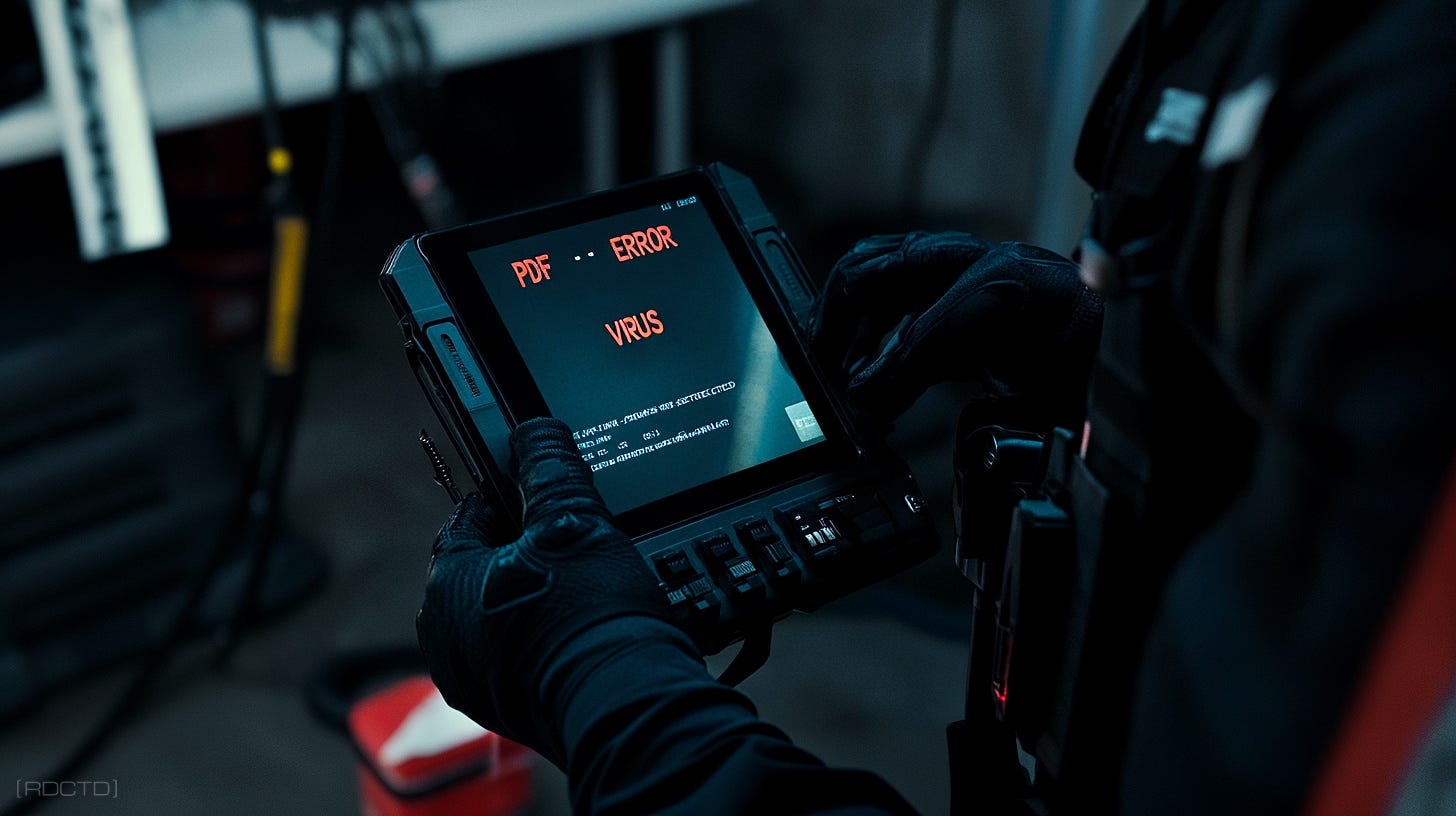What 'PDF Viruses' are and how to Defend Against Them
Whether you’re working behind a desk or behind enemy lines...
In the field, we’re trained to assume every file, every device, and every link is potentially hostile. Digital threats can be just as lethal as physical ones, one vector in both civilian and professional settings is the PDF file.
A weapon doesn’t always come with a trigger… sometimes, it comes with an attachment.
What looks like an innocuous document could be a trojan horse - loaded with malware designed to compromise your device, extract sensitive information, or provide remote access to adversaries. If you’re not treating PDFs with caution, you’re a soft target.
What is a “PDF Virus”?
A “PDF virus” isn’t a virus in the traditional sense, it’s shorthand for malicious code embedded inside a PDF file. PDFs, by design, can carry interactive elements like JavaScript, embedded media, forms, and links. These capabilities make PDFs useful but also make them dangerous. When weaponized, a PDF can:
Exploit software vulnerabilities in your PDF reader
Execute JavaScript code that can trigger downloads or exfiltrate data
Deliver payloads that install backdoors or remote access tools (RATs)
Phish credentials through deceptive forms
Perform drive-by downloads when the file is opened
Operatives have used booby-trapped documents in covert exchanges to track, compromise, or manipulate a target. The same tactics are used at scale in cyberattacks today, particularly in phishing campaigns and corporate espionage.
In layman’s: A PDF virus is a dangerous file that looks like a normal document but has hidden code that can harm your computer when you open it. Hackers use it to steal your info, spy on you, or take control of your system. To stay safe, only open PDFs from people you trust, after verification, and keep your software updated.
How PDF-Based Malware Works
Here’s a simplified version of how these attacks function:
Delivery: The malicious PDF is delivered via email, USB drive, compromised websites, or cloud sharing platforms. It might be disguised as a resume, invoice, contract, or even a classified briefing.
Trigger: Once opened, the document either exploits a known vulnerability in your PDF reader or uses embedded scripting (JavaScript is a common vector) to execute commands.
Payload: The payload is delivered. It could be:
A keylogger
A remote access tool
Ransomware
A data exfiltration utility
Persistence: Some PDF-based malware installs itself with persistence, ensuring it survives reboots and stays hidden.
In field operations, this type of attack can be used to track a target’s digital footprint or hijack communications, without ever stepping into their perimeter.
High-Risk Scenarios
Anyone can be a target, but high-risk profiles include:
Intelligence personnel and operatives
Journalists and dissidents
Executives in sensitive industries
Legal and healthcare professionals
Activists and whistleblowers
In covert operations, receiving an unsolicited PDF from a compromised asset or false front is a known vector. But in daily civilian life, the delivery method is usually email - often spoofed to appear legitimate.
How to Defend Against PDF Viruses
Digital tradecraft means never trusting anything at face value. You need a layered approach:
Use a Hardened PDF Reader
Avoid default or bloated readers like Adobe Acrobat unless it’s locked down. Instead:
Use PDF readers that disable JavaScript by default (SumatraPDF, MuPDF, or PDF-XChange Editor).
Check settings to disable embedded scripts, forms, and external content loading.
Keep Software Patched
Most successful PDF-based attacks rely on known vulnerabilities. Stay current:
Update your PDF reader, OS, browser, and antivirus software.
Use a vulnerability scanner if possible to check for weak points.
Don’t Open PDFs From Unknown Sources
This sounds basic, but social engineering works because people are predictable.
Verify the sender by out-of-band communication, a phone call or alternate email.
Be especially suspicious of unsolicited job applications, invoices, or court orders.
Use Sandboxing or Virtual Machines
For high-threat environments:
Open suspicious files in a sandboxed environment (e.g., Sandboxie).
Better yet, use an air-gapped virtual machine that doesn’t touch your host network.
Operatives in sensitive missions often rely on clean virtual machines spun up for single (use review of documents) burner boxes, essentially.
Use Endpoint Protection
Good antivirus isn’t enough. You want:
Behavior-based detection (EDR/XDR solutions like CrowdStrike, SentinelOne)
Real-time monitoring for unusual network connections or unauthorized file access
Alerting tools that notify you of unauthorized system changes
Inspect the PDF Before Opening
Advanced users and operatives might:
Use PDF analysis tools (PDF Examiner, pdfid, pdf-parser) to check for embedded scripts or suspicious elements.
Open PDFs as plain text first to scan for JavaScript or shellcode manually.
It takes time, but if your mission depends on operational security, this is the kind of diligence that keeps you in the clear.
Never treat digital files as passive. Every byte can carry intent. PDFs are a powerful tool in the adversary’s arsenal because of their versatility and trust factor. Whether you’re in a covert role or just handling sensitive personal data, apply the same mindset: Trust nothing, verify everything, and isolate risk.
Tradecraft isn’t just what you use in the field, it’s how you approach every interaction with the world, digital or physical. You don’t need to be paranoid. Just prepared.
And when in doubt, don’t open it. Burn it, digitally or otherwise.




